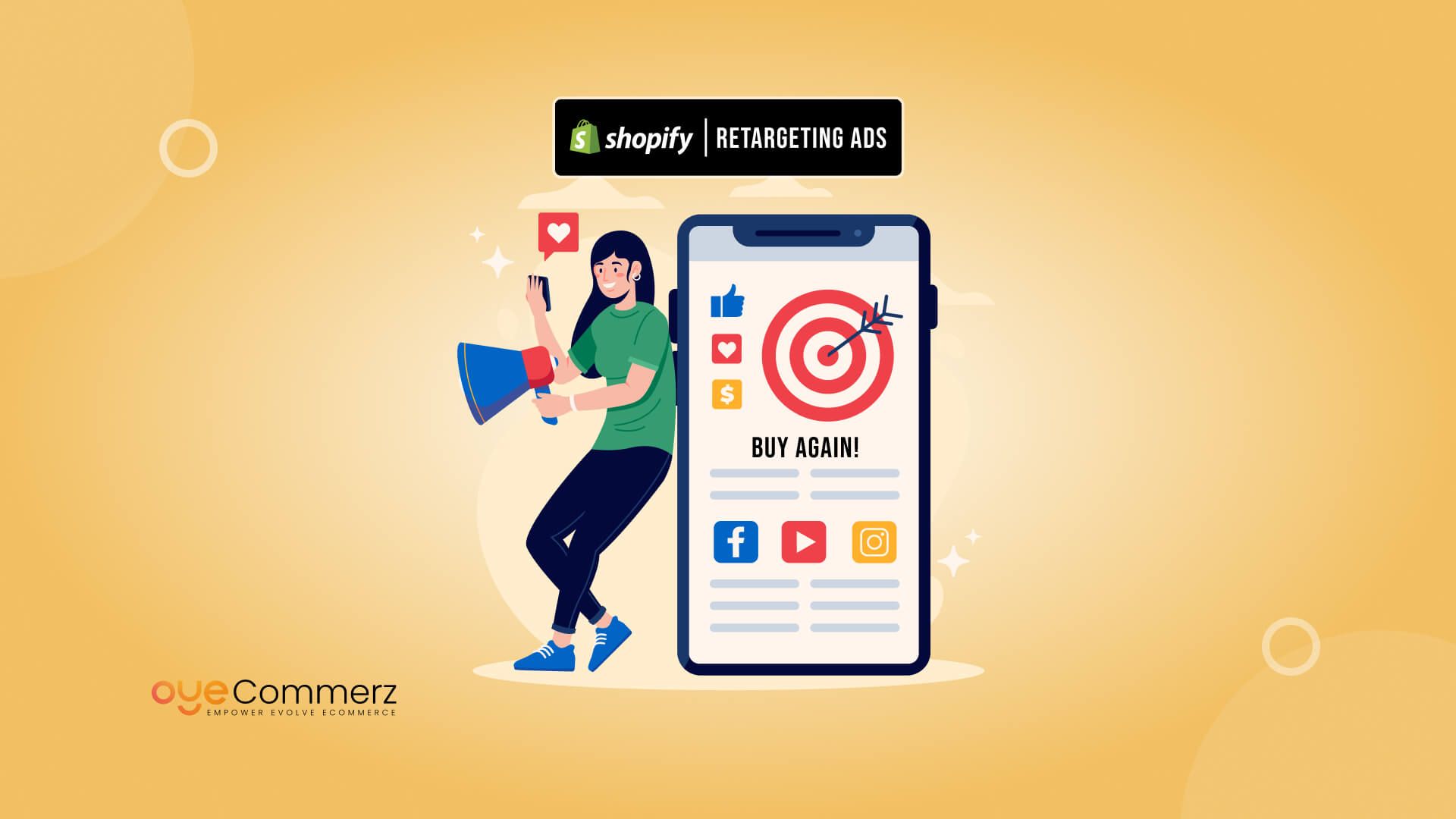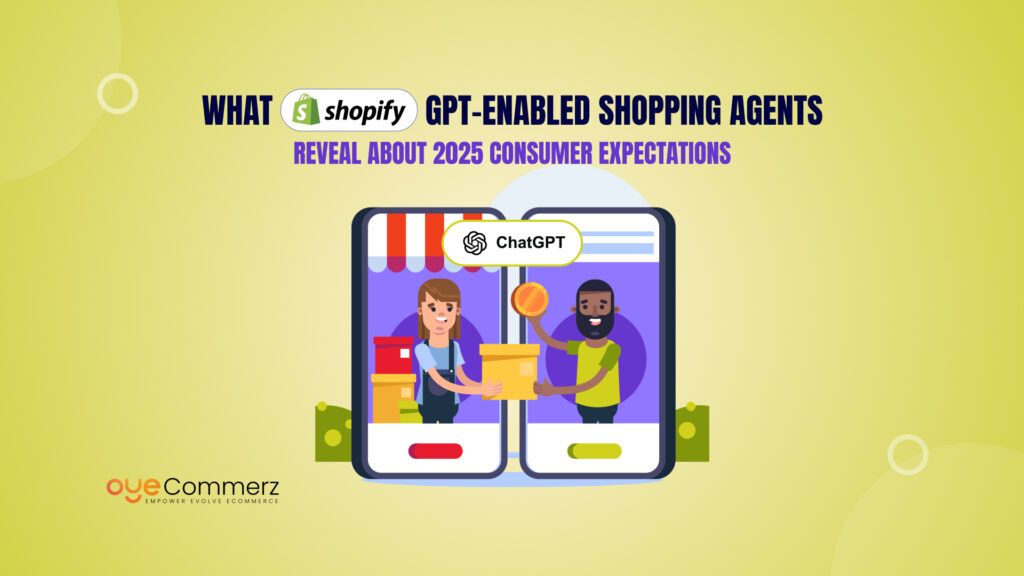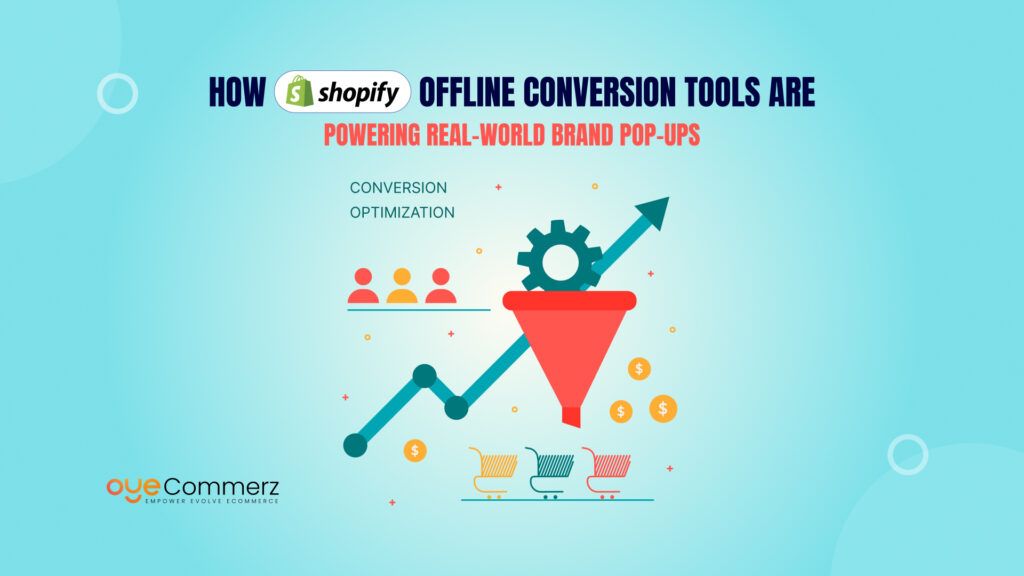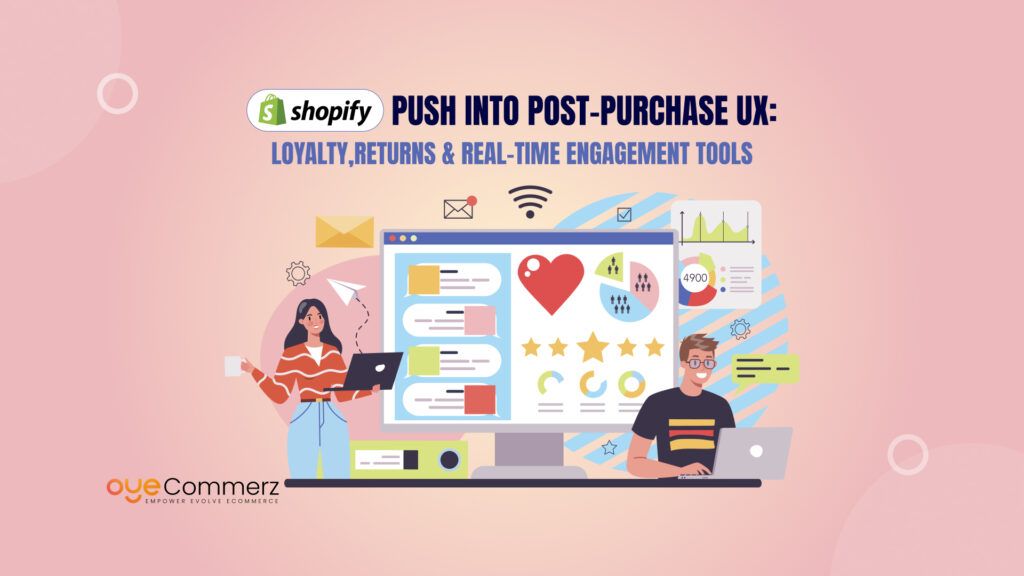Are you struggling to convert one-time visitors into loyal customers? You’re not alone! Many eCommerce businesses on Shopify experience high cart abandonment rates and miss out on re-engaging potential buyers. Customers browse, add items to their carts, and then disappear without completing the purchase, leaving businesses frustrated and revenue untapped.
But here’s the good news: Shopify retargeting ads can help you bring those lost shoppers back and encourage them to make a purchase. This blog is your ultimate guide to mastering Shopify retargeting ads. You’ll discover proven strategies, explore different types of retargeting ads, and learn actionable tips to boost conversions.
By the end, you’ll know how to optimize your ad performance, reduce wasted ad spend, and increase customer lifetime value (CLV). Whether you’re new to retargeting or looking to improve existing campaigns, this guide will set you on the path to higher sales and customer retention.
Table of Contents
ToggleUnderstanding Shopify Retargeting Ads
Retargeting ads are a powerful marketing strategy that allows Shopify store owners to re-engage potential customers who have previously interacted with their website but did not make a purchase. These ads are shown to users as they browse other websites or social media platforms, reminding them of the products they viewed and encouraging them to return and complete their purchase. But remember, retargeting isn’t just about optimizing your website, it’s about strategically nurturing leads and converting them into loyal customers by staying visible and relevant across multiple touchpoints.
Why Retargeting is Essential for eCommerce Brands
For eCommerce brands, especially those on Shopify, retargeting is crucial because most shoppers don’t make a purchase on their first visit. Retargeting helps bridge this gap by keeping your brand top-of-mind and giving hesitant shoppers a reason to return.
How Retargeting Works on Shopify
Retargeting relies on tracking technology, such as cookies and pixels, to monitor user activity. When a visitor lands on your Shopify store, a tracking pixel (such as Facebook Pixel or Google Tag) captures data about their behavior, which pages they visited, products they viewed, and if they added items to their cart. This data is then used to segment audiences and deliver personalized ads across different platforms.
Data You Collect for Retargeting
The success of retargeting campaigns depends heavily on the quality of the data collected. Shopify retargeting ads utilize various types of behavioral data, including:
- Page Views: Tracks which product pages a user visited.
- Cart Additions: Identifies users who added items to their cart but didn’t complete the purchase.
- Checkout Abandonment: Targets users who began the checkout process but left before finalizing payment.
With this data, you can craft highly targeted ad campaigns that speak directly to the interests and behaviors of your audience, ultimately driving higher conversions.
Why Retargeting Ads Are Critical for Shopify Success
Shopify stores face a significant challenge with cart abandonment, as nearly 69% of online shopping carts are left incomplete. This means that for every 100 potential sales, about 69 customers leave without purchasing. Without retargeting, these lost opportunities vanish, taking potential revenue with them. Retargeting ads play a critical role in recovering these lost sales by bringing hesitant shoppers back to your store.
Boosting ROI Through Retargeting
Retargeted customers are 70% more likely to convert compared to cold traffic. When you remind potential buyers about the products they viewed or added to their cart, they are more inclined to complete their purchase. Since these ads target an audience that has already shown interest, the cost-per-click (CPC) is often lower, and the return on investment (ROI) is significantly higher than traditional advertising methods.
Building Strong Brand Recall
In a competitive eCommerce landscape, building brand recall is essential. Retargeting ensures that your brand stays visible even after a customer leaves your website. When potential buyers see your ads repeatedly on social media, Google, or other platforms, they become more familiar with your brand. This familiarity builds trust and makes them more likely to choose your store when they’re ready to buy.
Increasing Customer Lifetime Value (CLV)
Retargeting doesn’t just help with cart recovery; it also plays a crucial role in increasing customer lifetime value (CLV). By nurturing existing customers with personalized retargeting ads, you can promote upsells, cross-sells, and exclusive offers, encouraging repeat purchases. Retargeting allows you to stay engaged with past buyers, ensuring that they continue to choose your store for future needs.
Incorporating retargeting into your Shopify marketing strategy not only helps recover lost sales but also strengthens customer loyalty, making it a powerful tool for long-term eCommerce success.
Types of Shopify Retargeting Ads You Should Use
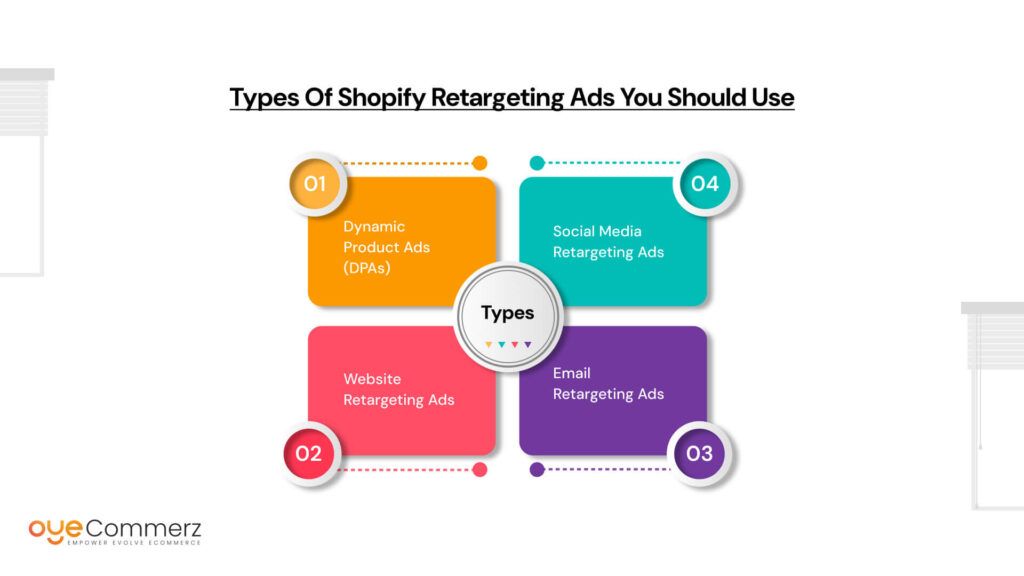
Retargeting ads are not one-size-fits-all. Depending on the behavior of your Shopify visitors, different types of retargeting ads can yield better results. Choosing the right type ensures that you show relevant ads to the right audience, increasing the likelihood of conversions.
1. Dynamic Product Ads (DPAs)
Dynamic Product Ads automatically show personalized ads based on the products a visitor viewed or added to their cart. These ads pull product details directly from your Shopify store and display them across platforms like Facebook and Instagram. They are especially effective for cart abandoners and product page viewers who need an extra push to complete their purchase. According to a study by WordStream, dynamic retargeting ads generate 3X higher engagement than standard display ads, making them a must-use strategy for Shopify stores.
2. Website Retargeting Ads
Website retargeting ads target visitors who bounced off your Shopify store without taking any meaningful action. These ads remind users of the products they viewed and encourage them to return. You can also showcase limited-time offers or discounts to entice hesitant shoppers. Website retargeting ads work well for re-engaging cold traffic and converting them into paying customers by addressing any initial objections they may have had.
3. Email Retargeting Ads
Email retargeting is perfect for re-engaging inactive subscribers or customers who haven’t interacted with your emails in a while. By tracking email engagement data, you can send personalized ads that promote tailored offers, special promotions, or product recommendations. These ads work best for past buyers, newsletter opt-ins, and those who abandoned their carts after email follow-ups.
4. Social Media Retargeting Ads
Social media retargeting allows you to reconnect with warm leads who have previously engaged with your brand on platforms like Facebook and Instagram. These ads are ideal for maintaining brand visibility and nurturing potential buyers over time. They can be used to promote new arrivals, highlight customer testimonials, or offer exclusive discounts. Since social media platforms have a vast user base, this type of retargeting ad helps maintain consistent touchpoints with your audience.
By leveraging these different types of retargeting ads, you can create a multi-channel approach that effectively brings shoppers back to your store and increases overall conversions.
Setting Up Shopify Retargeting Ads (Step-by-Step Guide)
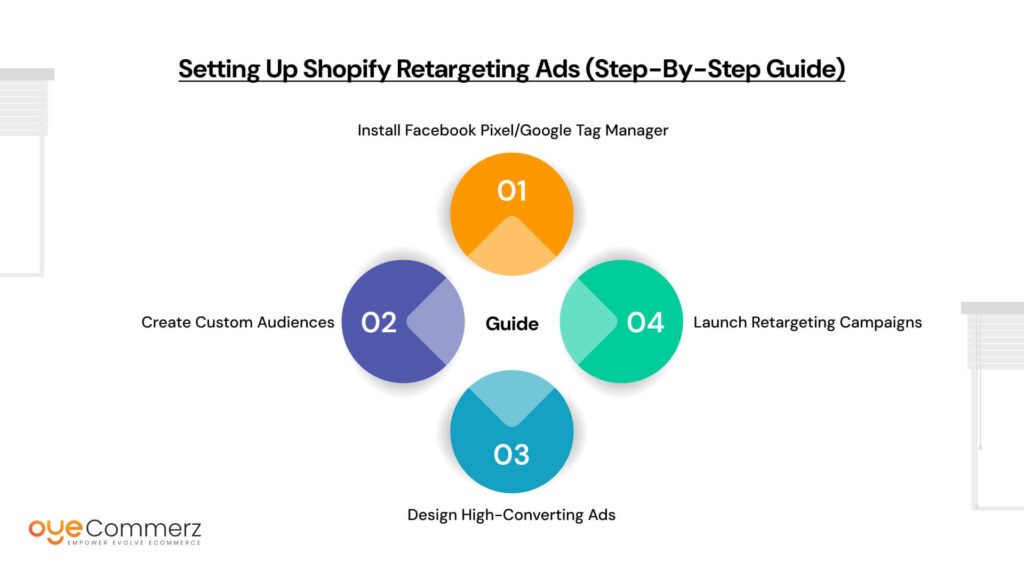
Setting up Shopify retargeting ads may seem complex at first, but breaking it down into clear steps makes the process manageable and effective. Following this guide ensures that your ads are properly configured to track user behavior, segment audiences, and drive high-converting campaigns.
Step 1: Install Facebook Pixel/Google Tag Manager
The first and most important step is to install a tracking pixel, such as Facebook Pixel or Google Tag Manager, on your Shopify store. These pixels collect data about user behavior and help you create custom audiences for retargeting.
- How to Install:
- Go to your Shopify admin panel.
- Click on the Online Store and select Preferences.
- Add your pixel ID under the Facebook Pixel or Google Tag Manager section.
- Save your changes, and the pixel will start tracking data immediately.
Step 2: Create Custom Audiences
Once the pixel is installed, you can create custom audiences based on user actions. Shopify’s customer data allows you to segment audiences by behaviors such as:
- Cart Abandoners: Visitors who added items to their cart but did not complete the purchase.
- Product Page Viewers: Shoppers who viewed specific products but didn’t take action.
- Past Customers: People who made a purchase and might be interested in related products.
To create custom audiences in Facebook Ads Manager:
- Navigate to Audiences.
- Select Create Audience and choose Custom Audience.
- Define the criteria based on user behavior from your pixel data.
Step 3: Design High-Converting Ads
To capture attention and drive conversions, your retargeting ads must be visually appealing and aligned with customer intent.
- Ad Copy Tips: Use clear, concise language that highlights the benefits of the product.
- Visual Elements: Include high-quality product images or carousel ads to showcase multiple items.
- Call-to-Action (CTA): Use compelling CTAs such as “Buy Now,” “Claim Your Discount,” or “Complete Your Order” to encourage immediate action.
Step 4: Launch Retargeting Campaigns
After designing your ads, it’s time to launch the campaign.
- Choose Ad Placements: Opt for placements on Facebook, Instagram, Google, and other platforms where your audience is most active.
- Set Your Budget: Allocate your budget based on audience size and campaign duration.
- Bidding Strategy: Choose between manual or automatic bidding to maximize ad performance while staying within your budget.
Set frequency caps to avoid ad fatigue and ensure that users do not see the same ad too many times. This keeps your ads fresh and prevents potential customers from feeling overwhelmed.
Building High-Converting Retargeting Audiences
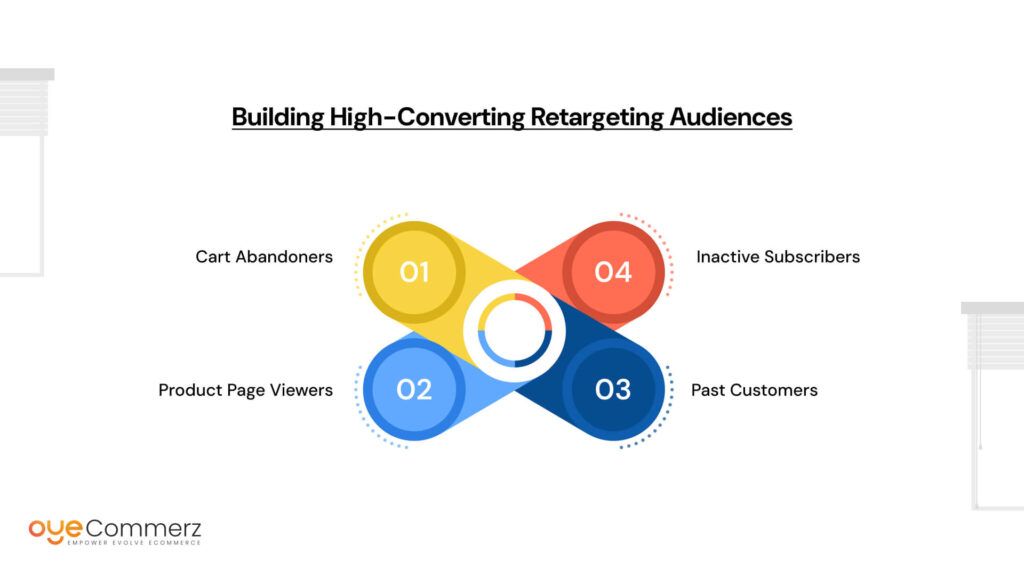
Creating high-converting retargeting audiences on Shopify requires more than just showing ads to previous visitors. You need to segment your audience based on behavior and intent, then serve personalized ads that address their needs. Here’s how to target the right audience effectively:
1. Cart Abandoners
Cart abandoners are often your hottest leads, but they need a gentle nudge to complete their purchase. Dynamic product ads (DPAs) work best for this audience as they showcase the exact items left in the cart, paired with an urgency-driven message like “Limited Stock Available” or “Offer Ends Soon.” To further sweeten the deal, offer a limited-time discount or free shipping to motivate them to act. Since 69% of online shopping carts are abandoned, targeting these users can significantly boost your conversion rate.
2. Product Page Viewers
Product page viewers have shown interest but didn’t take the next step. For these users, showcase complementary or similar products through carousel ads. Highlighting different variations, colors, or bundles encourages them to explore more options. You can also feature user reviews or bestsellers in the same category to build trust and create interest.
3. Past Customers
Retargeting past customers isn’t just about driving repeat sales, it’s an opportunity to increase customer lifetime value (CLV). Upsell related products or cross-sell complementary items that enhance their previous purchase. Consider introducing loyalty programs or exclusive member discounts to keep them engaged. Past customers more likely to convert compared to new prospects, making them a valuable segment to target.
4. Inactive Subscribers
Inactive email subscribers may need an extra push to re-engage. Entice them with new arrivals, personalized recommendations, or time-sensitive promotions. Emotional triggers like FOMO (fear of missing out) work particularly well here. For example, “Be the First to Grab Our New Collection” or “Limited Stock Alert” can reignite interest and prompt action.
By carefully segmenting and targeting these audiences, you can create highly personalized campaigns that resonate with different customer segments and drive stronger conversions. Integrating customized Shopify apps can further enhance this process by automating audience segmentation and delivering tailored ad experiences that align with user behavior and preferences.
Best Practices to Optimize Shopify Retargeting Ads
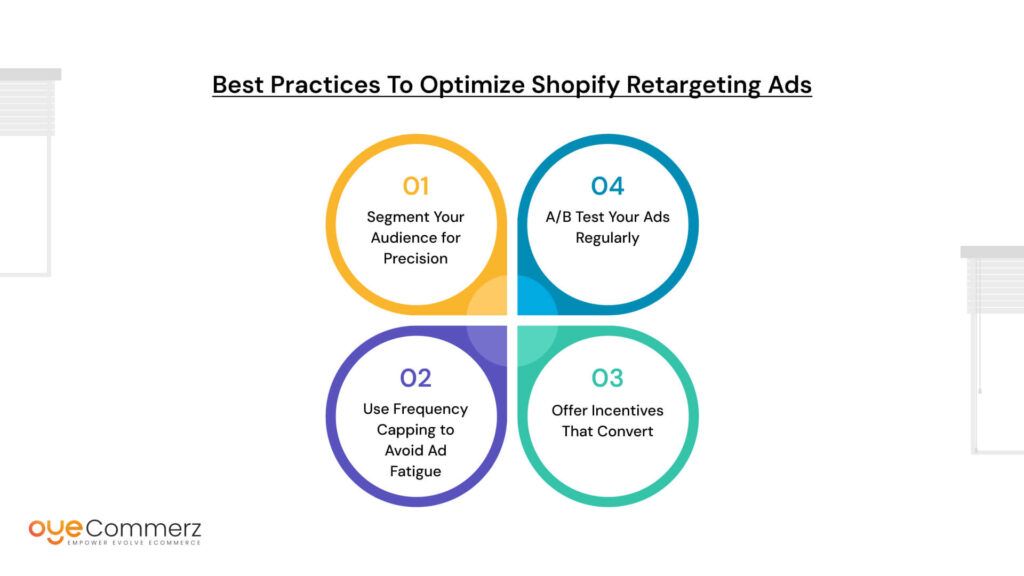
To maximize the effectiveness of your Shopify retargeting ads, it’s essential to go beyond simply launching campaigns. You need to fine-tune your strategies to ensure your ads resonate with the right audience and drive meaningful results. Here’s how:
1. Segment Your Audience for Precision
Not all website visitors have the same intent, so treating them equally reduces the effectiveness of your ads. Segment your audience based on their actions and level of engagement. Cart abandoners, product page viewers, and past customers each require different messaging and offers. By creating highly defined segments, you can deliver ads that are relevant and aligned with their purchase journey, resulting in higher conversions.
2. Use Frequency Capping to Avoid Ad Fatigue
Retargeting is powerful, but showing the same ad repeatedly can backfire. Without proper frequency capping, users may feel bombarded, leading to ad fatigue and a negative perception of your brand. To prevent this, set a frequency cap to limit the number of times a user sees your ad within a specific timeframe. Ideally, aim for a frequency of 3-5 impressions per user to maintain interest without overwhelming them.
3. Offer Incentives That Convert
Incentives are a great way to persuade hesitant buyers. Create time-sensitive offers that encourage immediate action, such as discounts, free shipping, or bundle deals. For cart abandoners, a well-timed discount can tip the scales in your favor. For past customers, exclusive offers like loyalty rewards or early access to new products can drive repeat purchases. Offering a compelling incentive aligned with the user’s intent increases the likelihood of conversion.
4. A/B Test Your Ads Regularly
What works for one audience segment may not work for another. A/B testing allows you to compare different ad variations and identify the most effective elements. Test different visuals, ad copy, calls-to-action (CTAs), and ad formats to determine which combinations generate the best results. Monitor performance metrics such as click-through rate (CTR) and conversion rate to refine your ads over time. Consistent testing ensures that your campaigns stay fresh and continue to perform well.
Analyzing Performance and Scaling Retargeting Campaigns
Running Shopify retargeting ads without analyzing their performance is like shooting in the dark. To ensure that your ads are driving meaningful results, it’s essential to track key metrics and refine your strategy based on the data collected. Here’s how to do it effectively:
1. Track Key Metrics
Start by focusing on the most critical performance indicators:
- Click-Through Rate (CTR): Measures how many users click on your ad. A low CTR suggests that your ad copy or visuals may not be engaging enough.
- Return on Ad Spend (ROAS): Calculates the revenue generated for every dollar spent on ads. A ROAS of 3:1 means you’re earning $3 for every $1 invested.
- Conversion Rate: Tracks the percentage of users who take the desired action after clicking the ad.
- Cost Per Acquisition (CPA): Monitors how much it costs to convert a user.
Additionally, keep an eye on bounce rates and ad frequency to avoid overwhelming your audience. If bounce rates are high, your landing page may need optimization.
2. Identify Winning Ads
Not all ads will perform equally. Analyze which ads drive the highest conversions and engagement. Look for patterns in your top-performing ads, such as the type of visuals used, the tone of the ad copy, and the call-to-action (CTA). For instance, if carousel ads showcasing multiple product variations outperform single-image ads, focus on scaling that format. Increase the budget for high-performing ads and allocate resources to expand their reach to a larger audience.
3. Refine Audience Segments
Audience preferences and behaviors change over time. Regularly update and refine your custom audiences to maintain relevance. Exclude audiences that have already converted to avoid wasting ad spend. For instance, if you’ve targeted cart abandoners and they’ve completed a purchase, move them into a “past customers” segment and promote upsells or cross-sells.
4. Leverage Lookalike Audiences
Lookalike audiences allow you to expand your reach by targeting users who share similar characteristics with your converted customers. For example, if your best customers are women aged 25-34 who frequently purchase beauty products, create a lookalike audience with these parameters. By doing so, you’re targeting a fresh audience that’s likely to convert, increasing the overall efficiency of your retargeting efforts.
Analyzing performance and scaling winning campaigns ensures that you maximize your ad budget while driving higher conversions and engagement.
Common Mistakes to Avoid with Shopify Retargeting Ads
Retargeting ads can be a game-changer for your Shopify store, but even minor mistakes can derail your efforts and reduce ROI. Avoid these common pitfalls to ensure your campaigns deliver consistent results:
1. Overloading Audiences with Too Many Ads
One of the biggest mistakes is bombarding your audience with too many ads. When users see the same ad repeatedly, they experience ad fatigue, which can lead to annoyance and even brand aversion. Let’s say you’re running a cart abandonment campaign and showing the same product ad five times a day. Instead of encouraging a sale, you’re likely pushing the customer away. Set a frequency cap to limit how often a user sees your ad, ideally 3-5 times within a week.
2. Poor Audience Segmentation
Targeting everyone who visits your Shopify store with the same ad is ineffective and expensive. Without proper segmentation, your ads may reach users who are not interested or ready to buy. For example, showing a “Buy Now” ad to someone who just viewed your homepage won’t be as effective as showing it to someone who added an item to their cart. Segment your audience based on behaviors such as product views, cart additions, and past purchases for more personalized and relevant ads.
3. Ignoring Ad Creative Refresh
Using the same ad creative for weeks or months can cause your audience to lose interest. If your ad visuals and copy remain unchanged, they’ll blend into the digital noise. Refresh your creatives regularly by testing new product images, modifying ad copy, or trying different CTAs. For instance, if a carousel ad featuring multiple products loses traction, replace it with a single-image ad showcasing a bestseller.
4. Not Testing Different Ad Formats
Relying on one ad format can limit your reach and impact. Experiment with various formats such as video ads, carousel ads, and single-image ads to identify what resonates best with your audience. A brand selling fitness apparel, for example, might find that a short video demonstrating product features outperforms static ads. A/B testing different formats ensures that you’re consistently optimizing your campaigns for better results.
Advanced Retargeting Strategies to Maximize Sales
Mastering Shopify retargeting ads is essential for maximizing conversions and increasing customer lifetime value. By leveraging strategies like dynamic product ads, sequential retargeting, and audience segmentation, you can effectively re-engage potential customers and guide them through the sales funnel. Retargeting not only helps recover lost sales but also boosts brand recall and customer loyalty over time.
To achieve consistent success, it’s crucial to analyze key metrics such as CTR, ROAS, and conversion rates while regularly refining your audience segments and ad creatives. Testing different ad formats and adjusting your strategy based on performance ensures that your campaigns stay relevant and effective.
Contact to Migrate your Site to Shopify Now
Conclusion
Maintaining a high-performing Shopify store requires continuous effort in optimizing speed, SEO, and security. A slow-loading site can drive potential customers away, poor SEO can leave your store invisible to search engines, and weak security can put your customer data at risk. Regular audits help identify and fix these issues before they affect your bottom line, ensuring that your store remains competitive and trustworthy.
To stay ahead, make it a habit to conduct regular Shopify performance audits and keep up with the latest features and updates. Proactively addressing performance gaps can prevent costly errors and keep your store optimized for growth.

